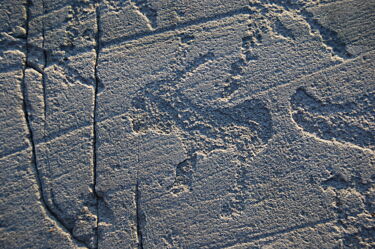
Object of the month: The hare and the Easter celebration
The rock art of Alta consists of more than 6000 figures, amongst them many different kinds of animals. It is usually the large game (reindeer, elk, bear, halibut) that is depicted, but sometimes the smaller animals are depicted as well. At one of the Ole Pedersen panels on the eastern side of the Hjemmeluft/Jiepmaluokta bay, we have uncovered two carvings of hares. These two hares are carved only one meter apart, and are the only two of the 6000 known figures. They are located 23 m.a.s.l. and are 6-7000 years old. Were they carved to convey the fact that the people back then also hunted and ate small animals? Or is there a completely different reason? Did the hare maybe symbolize fertility?
The hare has later been considered a symbol of fertility and new life, in part because it supposedly was one of the symbols for the Germanic goddess of fertility, Eostre. According to the Benedictine monk Bede (672/3-735 AD), pagan Anglo-Saxons held feasts in April to honor the goddess Eostre, but these had come to an end before his time and been replaced with the Christian celebration of the resurrection of Christ.
Our Easter celebration is a melting pot of pagan, Christian and Jewish traditions; for example (symbols of) the budding life of spring, the resurrection of Christ, and the Exodus. In addition, the English word “Easter” is probably derived from the name of the goddess Eostre.
Could it be that the hare, in connection with our Easter celebration, is obtained from the goddess Eostre and the pagan feasts in her honor? And could it be possible that the hare as a fertility symbol is even older, that we see traces of here in Alta?
Written by Ingvild Skau Mjelde, archaeologist